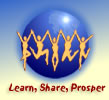 |
|
February 18, 2010
Volume 6, Issue 4
"How-to" tips and advice on increasing
business prosperity, published every other
Thursday.
To change subscription options, please
see the end of this message.
Sign
me up for this newsletter! |
|
Greetings!
-- Feature Article: What's on Your Meeting Agenda?
-- Note from the Author: Start off This Year's Meetings on the Right Foot
-- Special Message: Conduct Your Meetings Using Good Facilitation Techniques
Please add "Adele@LearnShareProsper.com"
to your whitelist or address book in your e-mail program,
so that you have no trouble receiving future issues.
You subscribed at LearnShareProsper.com,
and you're welcome to forward this newsletter to your
colleagues; please just keep the entire message intact.
If you wish to discontinue your subscription, please
use the links at the bottom.
|
|
 |
|
Start off This Year's Meetings on the Right Foot
 What are the consequences of holding ineffective meetings? Meetings held for the wrong reasons, that don’t involve the right participants, or that don’t use a disciplined meeting process can waste the time, resources, and funding of the business. What are the consequences of holding ineffective meetings? Meetings held for the wrong reasons, that don’t involve the right participants, or that don’t use a disciplined meeting process can waste the time, resources, and funding of the business.
Not only do they have the potential to make the participants feel perpetually frustrated and totally unproductive, they’re also a financial drain. Just in the area of cost, have you ever tried to calculate the expense of holding even a single unproductive meeting?
If you multiply the number of people sitting in a room by an average hourly rate, and add the price of employee benefits (overhead), you’ll see what I mean. And that’s the expense for a holding a single meeting, not including expenses for any related travel, food, or equipment.
You can then multiply that figure across the entire company to estimate the cost of meetings held per month and per year. So, as you can imagine, holding meetings, especially unproductive ones, can be a very expensive proposition! Fortunately, you can be highly successful when you use the right tools and techniques.
For these reasons, I hope you enjoy today's feature article, "What's on Your Meeting Agenda?" Please be sure to join the conversation by leaving your comments on my blog!

Adele Sommers, author of the "Straight
Talk on Boosting Business Performance" success
program
P.S. If you missed any previous issue, visit
the newsletter index!
|
|
 |
|
Conduct Your Meetings
Using Good Facilitation Techniques
Below
are some of the most effective techniques professional
facilitators use:
- Start on
time; don’t reward latecomers by waiting for
them.
- Decide on times for each
topic and stick to them.
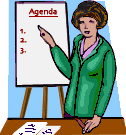
- Follow the
agenda; avoid hopping around.
- Discourage
side discussions.
- Set a "no
interrupting" rule.
- Stop, repeat,
and clarify the points people are making.
- Test for
closure before moving on to the next agenda item.
- Record decisions,
action items, and due dates for each topic.
- Summarize
the key decisions and action items before closing.
- End on time, or get everyone's agreement to continue!
|
|
 |
What's on Your Meeting Agenda?
by Adele Sommers
Conducting great meetings depends on several activities that occur before, during, and after each event. To help you establish the conditions for success and attain the very best results, this article lists essential tips on using meeting notices, agendas, and summaries.
Use Meeting Notices to Alert Your Attendees
Meeting notices act as an "early warning system" for your participants. You should use them regularly and give recipients plenty of lead time -- for example, at least a week. Avoid surprising people with a last-minute summons that disrupts their entire day. Below are some useful guidelines:

|
Be sure your meeting notice includes all key information:
1) Meeting date
2) Starting and ending times
3) Purpose and objectives
4) List of participants
5) Location with directions or access instructions, and
6) Proposed agenda
That way, everyone will know exactly what to expect, what to do, what their time commitment is, and what's in it for them! Request that people notify you well in advance if they will be unable to attend. |

|
If using a Web or telephone conferencing system, be sure to provide access instructions in your meeting notice, and any rules or protocols people should observe when logging or calling in to the conference.
For example, if needed, indicate the meeting time by time zone (use timeanddate.com/worldclock/converter.html for conversions), the call in number, and access code.
Explain remote meeting protocols, such as announcing oneself initially, and stating one’s name before making a comment. |
 |
Send out a reminder the day before the meeting. |
Do All Meetings Need an Agenda?
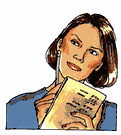 You may be wondering whether an agenda is absolutely necessary. The answer is, it depends! You may be wondering whether an agenda is absolutely necessary. The answer is, it depends!
An agenda provides structure; however:
- the fewer the people involved
- the fewer the topics you'll have to discuss
- the longer the time you have available, and
- the lower your expectations are...
...the less you'll need structure to get something done. If, say, you're just going out for a long lunch with a few people to toss around some ideas on a single topic, and you have no real expectations for what you need to accomplish, then you probably don't need an agenda.
Conversely, if you:
- involve more people
- to discuss more subjects
- in a compressed time frame
- with some very specific expectations for the outcome...
...then an agenda is an indispensable tool to help people focus on achieving the desired results. Agendas not only prepare attendees for what to expect, they also keep the meeting focused, and make the summarizing aspects much easier.
A sample meeting notice and agenda appear below:
Meeting Notice & Agenda
Date: Thursday, March 15, 2010
Time: 9:00 a.m. to 2:00 p.m. PST (a working lunch will be provided). For remote attendees, start at 10:00 MST, 11:00 CST, Noon EST, 5:00 p.m. UTC.
Purpose & Objectives: The Human Resources Department requests your participation to explore the personnel development needs of the company's centers of excellence in 2010-11. Based on the findings from this session, we will schedule follow-up events to fine-tune our planning process.
Requested Participants: Representatives from the following centers are asked to attend (or participate remotely via live Webinar conferencing):
* Marketing/Sales
* Customer Service
* Product Development
* Quality Assurance
|
* Order Fulfillment
* Publications & Media Design
* Information Technology
* Training & Development
|
Location: The Cranberry Building, 246 South St., Room B18. Please park in the Visitor area in the southwest corner of the lot behind the building. You will receive parking validations at the meeting. Overnight accommodations and shuttle transportation will be arranged for participants flying in from other locations.
Remote Access Instructions: For those participating via Webinar, use the standard company Webinar link and access meeting #123456. You can listen using voice over IP (VoIP), or call the bridge line at +01-555-555-1212 and use access code 54545#. You will see all electronic slide presentations and can interact with the on-site meeting attendees through a Webinar facilitator.
Proposed Agenda:
- Overview and agenda review by the VP of Operations (30 min.)
- Strategic Planning presentation (30 min.)
- Brainstorming breakout sessions, with facilitators (90 min.)
- Working lunch and reporting back to the main group (90 min.)
- Discussion, wrap up, and a review of the next steps (60 min.)
Handouts will be available on the server 48 hours prior to the meeting. The meeting summary and recorded Webinar will be available 48 hours afterward.
RSVP Requested: Please reply no later than Feb. 15, 2010 with the names and contact information for the representatives from your group who will be attending, either on-site or remotely. |
So, What about the Meeting Summary?
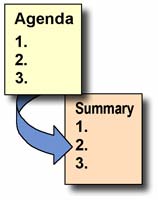
The agenda and summary are the two anchor points for the whole meeting process. They represent the beginning (here’s what we aim to do) and the end (here’s what we did do).
To create a summary, you simply go down the agenda topics, record the key points, decisions, and action items, and voila! You have a summary. It’s really not that hard, but it does take a little time and discipline.
The summary helps ensure that the valuable time people spend in meetings will not be wasted, as the recorded ideas can proceed to drive future actions and decisions.
A sample meeting summary, with action item reminders, appears below:
Meeting Summary with Action Items
This is a summary of the Strategic Planning & Brainstorming meeting held on March 15, 2010. The Human Resources Dept. called the meeting to explore the personnel development needs of the company's centers of excellence in 2010-11. The following representatives participated...
Based on the findings from this session, we will schedule at least two follow-up events to fine-tune our planning process.
Summary:
- The meeting began with the overview and agenda review by the VP of Operations, followed by the Strategic Planning presentation given by the executive planning committee.
- The brainstorming breakout sessions surfaced a total of 47 major objectives from the centers of excellence, as follows:
.
.
.
- During the wrap-up and review session, 15 key points emerged that Human Resources has agreed to investigate before the next scheduled planning session, as follows:
.
.
.
- Next Meeting Date: The next meeting will occur on the morning of May 17, 2010 from 9:00-12:00 PST. Further information about that event is forthcoming.
Action Items:
| Issue |
Priority |
Description |
Actionee |
Date Open |
Due Date |
1. |
High |
Explore options for... |
John R. |
3/15/10 |
5/17/10 |
2. |
Medium |
Answer concern about... |
Louise C. |
3/15/10 |
3/29/10 |
3. |
High |
Meet individually with... |
Martin D. |
3/15/10 |
5/17/10 |
|
In conclusion, meeting notices, agendas, and summaries encourage participants to contribute in an enthusiastic and meaningful way. They provide a robust structure that can compensate for any other aspects of meetings that are less than perfect.
Copyright 2010 Adele Sommers
|
|
 |
|
To Meet or Not to Meet?
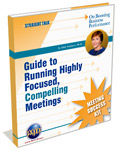 Would
you like to transform meetings from "profit stealers" to "profit boosters"? Why not make it your goal to eliminate those dysfunctional meetings, once and for all -- even if you're not the person running
them! Would
you like to transform meetings from "profit stealers" to "profit boosters"? Why not make it your goal to eliminate those dysfunctional meetings, once and for all -- even if you're not the person running
them!
You can do it with my “how-to”
tools for making meetings hum and participants sing on key. No more
sharps or flats to worry about with my Meeting
Success Kit by your side.
This expanded second
edition delivers seven powerful step-by-step checklists;
"guerrilla techniques" for diplomatically handling meeting challenges from the sidelines; in-depth case studies that can help you erase meeting
headaches forever; and 62 minutes of MP3 audio with a complete transcript.
|
|
 |
|
Adele Sommers, Ph.D. is the author of "Straight
Talk on Boosting Business Performance" -- an award-winning
Special Report and Workbook program.
If you liked today's issue, you'll love this down-to-earth
overview of how 12 potent business-boosting strategies
can reenergize the morale and productivity of your enterprise,
tame unruly projects, and attract loyal, satisfied customers.
It's accompanied by a step-by-step workbook designed
to help you easily create your own success action plan.
Browse the table of contents and reader reviews on the
description page.
Adele also offers no-cost articles and resources to
help small businesses and large organizations accelerate
productivity and increase profitability. Learn more
at LearnShareProsper.com.
LearnShareProsper.com/Business Performance_Inc.,
7343 El Camino Real, Suite 125, Atascadero, CA 93422,
USA. For information and Customer Service, call 805-462-2187,
or e-mail Info@LearnShareProsper.com. |
|
| |
|
|
| |
|
©2010
Business Performance_Inc., Adele Sommers, All rights
reserved. www.LearnShareProsper.com
Your feedback is always appreciated!
Write to us at info@LearnShareProsper.com.
We respect your privacy and do not give out or sell
subscriber names or e-mail addresses.
Please use the links below to take
yourself off our list or change your e-mail address.
|
|
|
